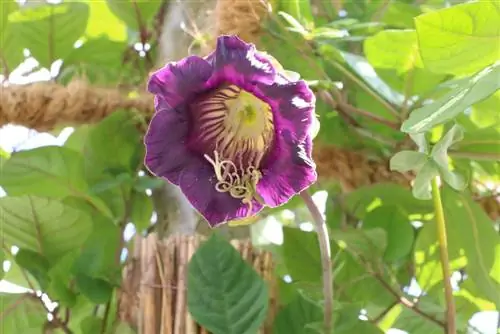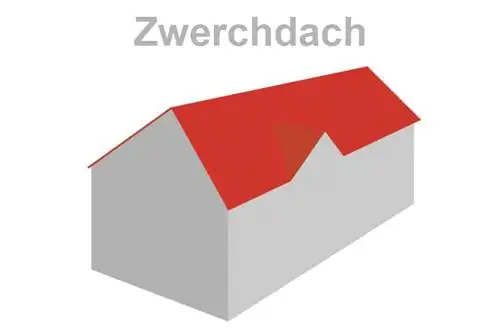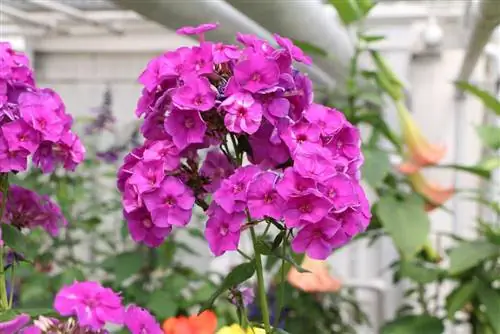- Author admin [email protected].
- Public 2023-12-17 03:39.
- Last modified 2025-01-24 12:45.
Climbing plants are very popular with garden owners. They serve as a privacy screen from the prying eyes of neighbors. Climbing plants are often used for privacy. The bell vine belongs to the climbing plant family and impresses with its evergreen growth in summer. The bell vine is also known as the claw vine or bell vine. It is a climbing plant whose origin was recorded in Mexico. The Cobaea scandens, which is the Latin name of the climbing plant, also serves well as a climbing plant on facades or garage walls. The fast-growing plant is also suitable for cultivation in pots. The growth height is a lot smaller in a pot. The Cobaea scandens is one of the plants that needs climbing aid to find the right direction. In summer, the bell vine enchants with purple leaves and a sweet scent reminiscent of honey. The climbing plant can quickly reach a height of four meters.
Sowing and propagation
The best time to sow seeds is in spring. In order for the seeds to germinate, they need a warm place. A place on the windowsill where it is bright and warm is well suited. You can also grow the seeds in a greenhouse. Put about just three seeds in a small pot. As soon as the seedlings have a height of 10 cm, they are trimmed. Repeat this process again as soon as the height of 10 cm has been reached. Only then do the seedlings receive a climbing aid in the form of a thin bamboo stick. Once the Ice Saints are over, you can place the seedlings in their designated spot. To propagate Cobaea scandens, take a few seeds from the plant after the flowering period. You can sow these as described. However, you can also buy the seeds from a gardening store.
Plants
The plants should only be brought outside after the Ice Saints. Please note that the soil should have permeable properties to avoid waterlogging. The young plants are placed in the ground, whereby the hole should be twice as large as the root ball. Please also note that the plant does not tolerate frost and should therefore overwinter in the greenhouse or winter garden. If you want to plant the bell vine directly in the garden, you should consider overwintering. Alternatively, you can leave the plant in the garden and risk the plant dying. The plant can be sown again in spring.
Repotting
If you want to leave the bell vine in a pot, it is advisable to repot the plant once a year, but at the latest when the roots grow out of the pot. Now use a pot that is 3 to 4 cm larger to give the plant enough space. Please note that the bell vine can become very heavy, which makes it not particularly suitable for keeping on a balcony.
Care
The plant needs a lot of water to grow quickly. It doesn't cope as well with dry phases. In summer, the Cobaea scandens should be watered sufficiently every day. Brown leaves are also removed at regular intervals. Although the bell vine prefers nutrient-rich soil, you should still add fertilizers very sparingly. If overnutrition occurs, the plant stops producing flowers and becomes downright lazy to bloom.
Location
For good growth, the bell vine needs a sunny location that is also well protected from the wind. The soil should be nutrient-rich and permeable. Waterlogging must be avoided at all costs as this would cause the plant to die. If you want to cultivate the Cobaea scandens in a pot, make sure that the pot is not too small. So that the bell vine can grow well in the pot, you should line the lower area with some gravel. This ensures that excess irrigation water can drain away better and waterlogging does not form. In addition, the plant does not require much care.
Pouring
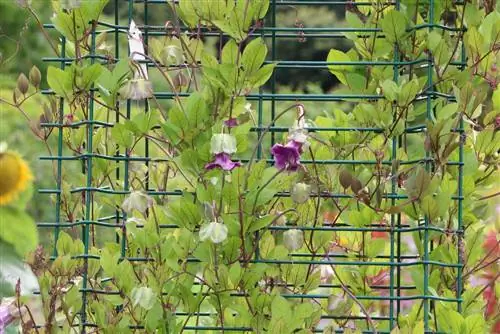
In the summer months, Cobaea scandens needs a lot of water. Especially in June, when the plant produces its first flowers, you should not be sparing with water. In the cooler months it is sufficient if the Cobaea scandens receives enough water two to three times a week.
Fertilize
Avoid excessive fertilization, otherwise the bell vine will become lazy when flowering. It immediately stops flowering. It would be ideal if you could add some compost to the plant once a year. Other fertilizers are then no longer necessary.
Cutting
If you want to let the plant overwinter, it makes sense to cut it properly before the onset of frost. If the bell vine is growing too quickly, you can also easily cut the Cobaea scandens into shape at other times.
Wintering
Before the Cobaea scandens is moved to a warm place to overwinter, it is advisable to cut the plant down to 50 cm. Since the bell vine comes from Mexico, it cannot tolerate frost and should therefore overwinter in the greenhouse. You can also let the Cobaea scandens overwinter in the apartment or in the winter garden. Choose a sunny and very bright location. Constant temperatures of 10 to 15 degrees are optimal. Water the plant regularly even in winter.
Diseases and pests
As a rule, there are no special diseases of the plant. Young plants are often attacked by snails. However, as soon as the plants get older, the snails leave them and go their way. Overwintering can lead to an infestation of spider mites. Aphids also love the climbing plant and like to attack it. Spraying the plants with soapy water helps against spider mites and aphids. You should repeat this process until there are no more spider mites and/or aphids.
Appearance
The flowers appear from July to October and initially appear white or yellow-green and only later take on a violet-bluish color. The bell vine branches very strongly and grows up to 2 meters high in our latitudes.
The plant likes to be sunny and protected and prefers nutrient-rich and humus-rich soil. Slightly shady locations are still acceptable, but then it doesn't grow as lushly. Locations on the east and west sides are ideal. If you use standard soil, you should mix in about 1/3 of sand. The bell vine should always be kept slightly moist. Because it grows very quickly, it requires a lot of water. To do this, it must be sufficiently supplied with nutrients. It is ideal to work horn shavings into the soil before planting. Locations that are too nutrient-rich can reduce their willingness to flower. In order for the plant to branch well and bloom profusely, the shoots must be regularly trimmed.
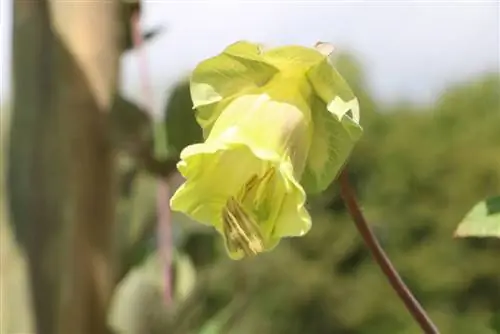
The bell vine is propagated by sowing, from mid-March in the greenhouse or 2 seeds in an 8 to 10 cm large pot with nutritious potting soil. They are further cultivated at 18 degrees Celsius and uniform humidity. Pruning once or twice promotes branching and dense growth. When frost no longer occurs, the young plants can be placed in nutrient-rich, loose garden soil. The planting distance should be 30 cm.
The bell vine needs solid climbing aids that the tendrils can wrap around. It is very suitable as privacy, wind and sun protection.
If you want to keep the bell vine as a container plant, you must provide a sufficiently large planter. The plants usually don't grow that big in the pot.

